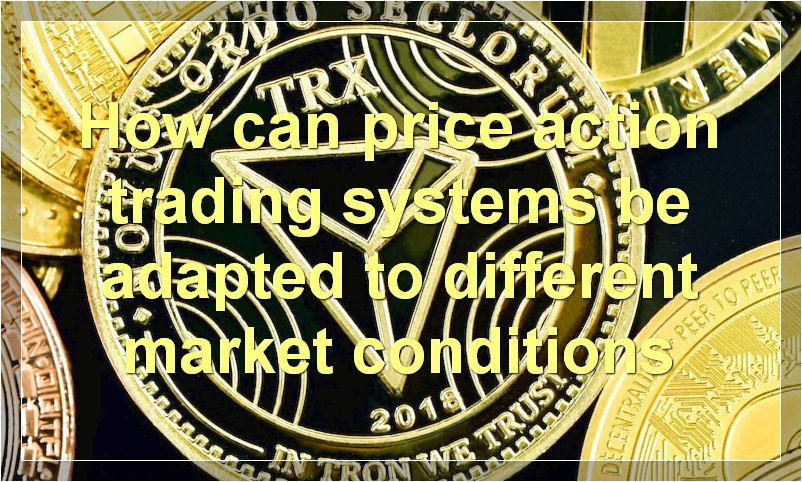If you’re looking to get started in price action trading, there are a few systems you can use to get started. In this article, we’ll go over some of the most popular price action trading systems and how they can benefit your trading.
What is a price action trading system
A price action trading system is a method of trading that uses price movements to make decisions. This means that instead of using indicators or other technical analysis tools, price action traders simply observe the price and make decisions based on what they see.
Price action trading can be used on any time frame, but most traders prefer to use it on longer time frames such as the 4-hour or daily chart. This is because longer time frames produce more reliable signals and allow for better risk management.
There are many different ways to trade price action, but one of the most popular is to look for candlestick patterns. Candlestick patterns are created when the price forms certain shapes on the chart, and these shapes can give clues about future price movements.
Another popular way to trade price action is through support and resistance levels. These are areas where the price has previously found difficulty breaking through, and they can be used to predict where the price might struggle in the future.
If you’re interested in learning more about price action trading, there are many resources available online. You can start by reading some of the articles on this website, and then move on to more advanced concepts once you have a better understanding of the basics.
How can price action trading systems be used to trade forex markets

Price action trading is a form of technical analysis that relies on past price movements to predict future price movements. Price action trading systems use price charts to identify profitable trading opportunities.
Price action trading systems are easy to use and can be applied to any time frame. Price action traders look for specific price patterns that have formed over time, and then they place their trades accordingly. Price action trading systems can be used to trade forex markets by identifying market trends and making educated guesses about future market direction.
When used correctly, price action trading systems can be a highly effective way to trade forex markets. However, it is important to remember that no system is perfect, and there will always be some element of risk involved.
What are some common features of price action trading systems
There are many different types of price action trading systems, but there are some common features that they all share. First, price action trading systems focus on price movements, rather than indicators or other forms of technical analysis. This means that they are looking at the raw price data to make their decisions. Second, price action trading systems often use support and resistance levels to make decisions. These levels are areas where the price has difficulty moving past, and they can be used to enter or exit trades. Third, price action trading systems typically use candlestick charting to make their decisions. This type of charting includes information about the open, high, low, and close prices for each period, as well as the volume traded. Fourth, many price action trading systems use Fibonacci levels to make decisions. These levels are based on mathematical relationships between numbers in the Fibonacci sequence, and they can be used to identify potential support and resistance levels. Finally, many price action trading systems use some form of risk management, such as stop-loss orders, to limit potential losses.
How do traders develop and test price action trading systems
Price action trading is a type of technical analysis that looks at the price movement of a security rather than using indicators. Price action trading systems can be developed by looking for patterns in the price data that have predictive value. These patterns can be tested on historical data to see if they have the ability to generate profits.
What are the benefits and drawbacks of using price action trading systems
Price action trading systems can have both benefits and drawbacks. One benefit of using a price action system is that it can help to simplify your trading. By focusing on price patterns and signals, you can eliminate the need for complex indicators and strategies. This can make it easier to stay disciplined and focused when trading.
However, there are also some potential drawbacks to using price action systems. One is that they may not work in all market conditions. Another is that they can be difficult to learn and master. If you are new to trading, it may be better to start with a simpler system.
How can price action trading systems be adapted to different market conditions

Price action trading systems are designed to take into account the changing conditions of the markets. By understanding how the market is behaving, price action traders can make adjustments to their systems to better adapt to the current conditions.
One way to do this is by using different time frames to trade. For example, if the market is trending lower, a trader might use a longer time frame to trade, such as a daily chart, to better capture the down trend. Conversely, if the market is choppy or ranging, a trader might use a shorter time frame, such as a 5-minute chart, to avoid getting caught in false moves.
Another way to adapt price action trading systems to different market conditions is by using different technical indicators. For instance, in a trending market, traders might use moving averages or trend lines to help identify the direction of the trend. In a choppy market, on the other hand, traders might use oscillators or support and resistance levels to trade the range.
Ultimately, it’s up to each individual trader to find what works best for them. By experimenting with different time frames and indicators, traders can develop price action trading systems that can be adapted to any market condition.
What are some common pitfalls that traders face when using price action trading systems
There are a few common pitfalls that traders face when using price action trading systems. One is over-optimizing the system. This means that the trader spends too much time trying to find the perfect set of rules or indicators, and as a result, they never actually get around to trading. Another pitfall is under-optimizing the system. This means that the trader doesn’t spend enough time testing and tweaking the system, and as a result, they may end up with a system that doesn’t work well in live market conditions.
Another common pitfall is trading too frequently. This can lead to overtrading, which can deplete your account balance quickly. It can also lead to missed opportunities, as you may not be able to enter or exit trades at the ideal times.
Finally, another common mistake is not managing risk properly. This can lead to large losses if the market moves against you. Proper risk management includes using stop-loss orders and limiting your position size.
By avoiding these common pitfalls, you can give yourself a better chance of success when trading with price action systems.
How can traders overcome the challenges associated with price action trading systems
Price action trading can be a great way to trade the markets, but it can also be fraught with challenges. Here are some ways that traders can overcome the challenges associated with price action trading:
1) First and foremost, traders need to have a clear and concise plan. This plan should outline the different aspects of their price action trading system, including entry and exit criteria.
2) Traders need to be disciplined in following their plan. This means sticking to their entry and exit criteria, even when it might be tempting to stray from the plan.
3) Traders need to be patient when trading. This means waiting for the perfect setup to come along, rather than taking trades that are not in line with their system.
4) Traders need to have a good understanding of market conditions. This will help them know when the market is ripe for price action trading and when it is not.
5) Last but not least, traders need to be prepared for losses. Even the best price action trading systems will experience losing trades from time to time. It is important to accept these losses and move on quickly to the next trade.
What are some tips for developing successful price action trading systems
There is no one-size-fits-all answer to this question, as the best price action trading system will vary depending on the individual trader’s goals and preferences. However, there are some general tips that can help to make a price action trading system more successful.
One important tip is to focus on a small number of markets and to really get to know them inside out. This way, you will be better able to identify repeating patterns and develop a feel for how these patterns play out over time. It is also important to have a clear and well-defined trading strategy, so that you know exactly when to enter and exit trades. And finally, it is crucial to stick to your system and not let emotions get in the way of your trading decisions.
What resources are available to help traders learn more about price action trading systems
There are many resources available to help traders learn more about price action trading systems. Some of these resources include online forums, videos, books, and courses. Each of these resources can provide valuable insights into how these systems work and how to trade them effectively. By taking the time to learn about price action trading systems, traders can improve their chances of success in the market.

